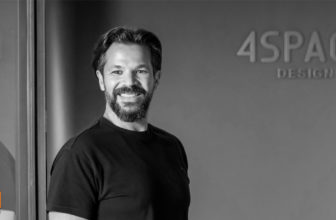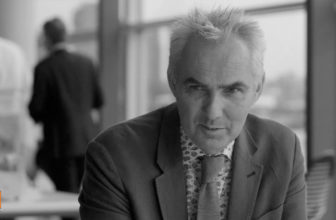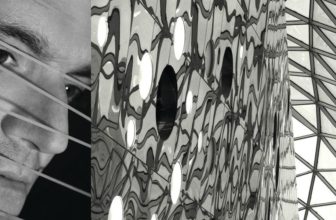Patrick Speck, LIXIL Global Design
What was GROHE’s inspiration to launch the digital experience hub, GROHE X?
The pandemic presented us with the major challenge of not being able to hold physical events such as trade fairs or customer meetings in the usual way. And anyone who has visited one of our booths knows that we want to inspire our customers with a unique brand experience. Thus, it quickly became clear that we needed to create our own digital solution to meet our expectations for distinctive brand showcasing, design and customer-centricity: The idea of GROHE X was born. Now, the digital platform is much more than a trade fair substitute but rather a central brick in our customer communication – definitely here to stay.
How is GROHE X helping the brand name grow and gain even more trust?
GROHE X is a multimedia content hub that offers our audience a look behind the scenes. From trend reports, product showcases to service-oriented how-to-videos and immersive 360°rooms, the digital platform provides a deep dive in different topics around our brand and industry. This allows us to get closer to our customers and to deliver exclusive insights into, for example, the latest hotel that has installed our products or our production plants – from your own desk, seven days a week and around the clock. This increases transparency and makes us more tangible as a brand, as we also show the minds behind the products.
However, it also offers us unprecedented scaling opportunities: We can tailor content to the interests of target groups, in many different languages, so customers can create their own GROHE experience. We can inform and inspire in a completely customer-centric way. It is important to us that personal contact is not neglected. That’s why you can make appointments on the platform or take part in interactive events.
We are very proud of the fact that GROHE X is unique in the sanitary industry in terms of its manifold fields of use.
The digital experience hub has helped GROHE connect closely to its customers—however, the group has always centered its designs around humans, so what were your strategies to design products that are tailored to the customers’ needs before the digital hub?
The digital experience hub GROHE X is just further proof that customer centricity is central to all areas of our organization. However, it has not changed the way we develop products. Here, the user has always been our absolute focus and is at all times the starting point of any design process. In order to understand what consumers expect from their living spaces and which product solutions match these expectations, we invest a lot of time in researching and analyzing trends and consumer insights. We are convinced that we can only create relevant products that improve users’ everyday lives if we provide concrete answers to social trends and thus respond directly to changing consumer needs.
We are guided by three main macro trends: Urbanization, Health and Wellbeing as well as Sustainability.
What is an example of how Urbanization guided LIXIL through decision-making and product design?
The Urbanization macro trend results in a record numbers of people living in cities, making space and affordable housing become scarce. This densification in the urban landscape requires a rethinking of proven concepts. People want to enjoy the benefits of big cities without compromising comfort. From this, the Micro Living trend has emerged: With intelligent, condensed living concepts which are reduced to the essential, we can make efficient use of space and still enhance our quality of life.
Urbanization also leads to new living spaces: The borders of bathroom and bedroom as well as kitchen and living room are dissolving. The kitchen for instance became the heart of the home where the family and social life takes place. The once functional room becomes a living space, which also increases the expectations of the products – consumers are looking for smart, intuitive helpers that simplify everyday routines.
A product example for this is our watersystem GROHE Blue. Consumers can enjoy filtered, chilled and, if desired, carbonated water directly from the kitchen faucet. This intelligent functionality saves valuable space and time and also has a major sustainability effect, as plastic bottles become unnecessary.
At the same time, consumers want to be actively involved in the design process and products should reflect their individual style as well as the design of the other rooms.
We are addressing this trend with our GROHE Colors Collection. We have curated a color palette that offers the greatest possible flexibility which does not follow short-term trends and is globally relevant. It is important for us that we offer a harmonious
color concept for the whole bathroom or kitchen, thus simplifying the selection. Matching colors from faucet, shower system to flush plate and accessories or faucets and kitchen sinks.
How are architectural and interior design trends informing the design process of GROHE?
Of course, we look beyond our industry to gain inspiration and are in frequent dialogue with architects, designers and trend experts. We want to learn directly from the experts who are using our products every day.
However, we must abstract fads from long-term trends. In the case of GROHE products, we speak of fixed fixtures that demand design permanence. Of course, quality also plays a major role here – especially in the bathroom and kitchen area. We always need to find a balance between the latest interior trends, timeless design and our uncompromisingly high quality standards in materials and finishes.
The pandemic has forced people to stay home for longer times—how did that change the way LIXIL designs its housing products?
Transformation processes are traditionally somewhat slower in the sanitary industry. But where we see a very clear change in consumer behavior is the increased need for health and wellbeing. This encompasses the bigger need for hygiene which leads to hand washing routines at home, at work and in public spaces being questioned. Today, more than ever, having to touch a conventional faucet – especially in a public bathroom – is not an attractive option. This changed awareness for hygiene has put our touchless products centre stage.
And it is not going to disappear any time soon, which is why the question of how we can meet the increased need for hygiene even better with our solutions in the future will continue to occupy us.
On top, the idea of the bathroom as a spa or wellness area has really accelerated. The bathroom has become a private retreat from the outside world – an oasis of wellbeing to find peace of mind. As consumers take better care of their health and wellbeing this is having some profound implications. This means that the bathroom is no longer a space purely dedicated to the everyday function of hygiene. Consumers are looking for products that provide this feeling of wellness, for example, by offering different spray patterns for shower solutions that can be adjusted to suit personal moods.
Technology has brought GROHE X into reality—with the impact of technology and the goal of sustainability in mind, how are you expecting LIXIL products to look like and function in the future?
We see that consumers are more aware than ever of the consequences their actions are having on our planet. They demand brands and products which enable them to live better lives. Water is one of the most precious resources and is core to our business. Therefore, we constantly need to ask ourselves: How can we do more with less?
Here, we are enabling the consumer to live more eco-consciously, thanks
to our water-saving technology GROHE EcoJoy which helps to reduce water consumption by up to 50% without compromising the performance.
Another example is our GROHE Plus faucet which comes with a temperature display. Not only to offer users the possibility to accurately control the water temperature but also to supports users’ increasing desire for sustainable living. This is made possible by the principle of “nudging”, a concept from behavioral economics. Through the visual color change, users are made aware of when hot water is flowing – often unnecessarily – in order to avoid wasting energy. This promotes responsible use of the valuable resource water and saves energy at the same time.





